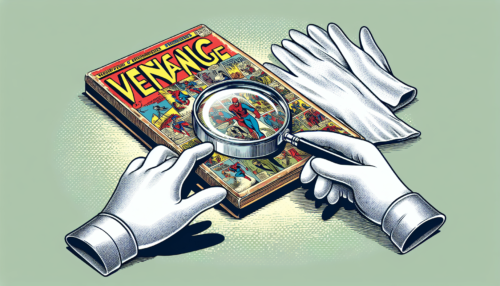A Guide to Accurately Grading Comic Books” delves into the intricate process of evaluating comic books with precision, an essential skill for collectors and sellers alike. This thorough examination commences with a historical overview, detailing the evolution of comic book grading. It then transitions into current methodologies and trends that shape modern grading standards. Key concepts such as “Mint,” “Near Mint,” and “Fine” are meticulously defined, ensuring clarity for readers.
The article progresses with detailed subtopics, including specific case studies that illustrate grading principles in action. By comparing varying perspectives and assessing their impacts, the piece provides a balanced and authoritative discussion. Furthermore, it explores future directions and implications in the sphere of comic book grading, offering well-founded predictions and their potential effects on the industry. Concluding with a recap of critical points, the article leaves readers with a thought-provoking question, encouraging further engagement and exploration.
How do you grade comic books accurately? This question resonates with comic book collectors, enthusiasts, and sellers who understand that proper grading is crucial for determining a comic book’s value. Accurate grading not only influences pricing but also ensures the book’s marketability and preserves its historical significance.
Table of Contents
Overview
Comic book grading is the process of assessing a comic book’s condition and assigning it a grade, usually on a scale from 0.5 to 10. The relevance of accurate grading cannot be overstated, as it impacts both buyers and sellers. With the increasing popularity of comic book collecting, understanding the grading process has never been more timely.
Thesis Statement
This guide explores the intricacies of accurately grading comic books, delving into historical context, current trends, essential concepts, and practical examples to equip collectors and sellers with the knowledge required to assess comic book conditions reliably.
Historical Context
Comic book grading is not a recent phenomenon. As early as the mid-20th century, dedicated collectors and dealers began to establish informal grading standards to facilitate transactions. The advent of professional grading services, like the Certified Guaranty Company (CGC) in 2000, formalized these standards, leading to a more systematic approach. This professionalization has made the comic book market more transparent and trustworthy.

Current Trends
Today, comic book grading trends are influenced by technological advancements and market demands. Digital tools, such as high-resolution scanners and software, make it easier to examine books in detail. Additionally, the rise of online marketplaces means that accurate grading has become even more crucial for remote transactions. Keywords that define this trend include “digital grading tools” and “online comic book marketplaces.”
Key Concepts and Definitions
Understanding comic book grading requires familiarity with several key concepts and terms:
- Mint Condition (10.0): A flawless comic book with no wear.
- Near Mint (9.4-9.8): Almost perfect, with only minor defects.
- Very Fine (8.0-9.0): Well-preserved with slight wear.
- Fine (6.0-7.5): More wear evident but still collectible.
- Very Good (3.5-5.5): Marked wear but intact and readable.
- Good (1.8-3.0): Significant wear but complete.
- Poor (0.5-1.5): Extremely worn and possibly incomplete.
Each grade reflects detailed criteria concerning the comic’s cover, spine, pages, and overall integrity.
Detailed Exploration
Cover and Spine Examination
The cover and spine are usually the first areas examined. Factors such as color retention, glossiness, creasing, tears, and spine rolls are scrutinized. A pristine cover with vibrant colors and no damage is indicative of a higher grade.
Table 1: Cover and Spine Defects
| Grade | Spine Condition | Cover Condition |
|---|---|---|
| 10.0 Mint | Perfectly aligned, no wear | Vibrant colors, no creases or tears |
| 8.0-9.0 VF | Slight wear, minor spine roll | Slight wear, minor creases |
| 4.0-5.5 VG | Noticeable wear and roll | Noticeable creases and discoloration |
| 0.5-1.5 Poor | Extensive wear and roll | Major creases, tears, discoloration |
Page Quality
The pages within a comic book are as crucial as the cover and spine. Examining the page quality includes checking for yellowing, foxing (spotting), and brittleness. High-grade comics will have supple pages with minimal discoloration.
Table 2: Page Quality Indicators
| Grade | Page Color | Brittleness | Foxing |
|---|---|---|---|
| 10.0 Mint | White | None | None |
| 8.0-9.0 VF | Off-white to white | Minimal | Minimal |
| 4.0-5.5 VG | Tan to brown | Moderate | Moderate |
| 0.5-1.5 Poor | Brown and fragile | Extensive | Extensive |
Structural Integrity
Assessing structural integrity involves evaluating the comic book’s staples, binding, and any restoration work. Missing staples or amateur restoration attempts can significantly lower a book’s grade.
Table 3: Structural Integrity Indicators
| Grade | Staple Condition | Binding | Restoration Work |
|---|---|---|---|
| 10.0 Mint | Perfect | Firm and aligned | None |
| 8.0-9.0 VF | Slight aging | Slight looseness | Professional and minor |
| 4.0-5.5 VG | Rusty or missing | Noticeable looseness | Amateur or extensive |
| 0.5-1.5 Poor | Detached or missing | Broken | Unprofessional or glaring |

Example 1: The Case of “Amazing Fantasy #15”
“Amazing Fantasy #15,” the first appearance of Spider-Man, serves as a robust case study. In 2011, a near-mint copy (graded 9.6) sold for $1.1 million. Examining its condition reveals a pristine cover, superb page quality, firm binding, and minimal wear. This example underscores how meticulous grading can translate into significant financial returns.
Example 2: “Action Comics #1” Low-Grade Copy
On the flip side, a “Good” condition (graded 2.0) copy of “Action Comics #1” sold for $226,000. Despite its significant wear, missing pages, and heavy restoration, the book’s historical value contributed to its high price. This instance highlights the importance of grading even when a comic is not in perfect condition.
Comparison of Different Perspectives
Different grading services often emphasize different aspects of the grading process. While CGC is known for its strict adherence to physical condition, other entities like CBCS might give weight to the comic’s readability and historical context.
Table 4: Grading Service Comparison
| Grading Service | Emphasis | Distinguishing Feature |
|---|---|---|
| CGC | Physical condition | Transparent casing with detailed labels |
| CBCS | Readability and history | Includes signature verification service |
Impact Assessment
These varying perspectives impact the market significantly. Collectors may prefer one service over another based on their collecting priorities—whether they value physical perfection or historical context more. This diversity allows for a richer, more nuanced comic book market.
Future Directions and Implications
Predictions
Future trends in comic book grading may involve more automated systems using AI to analyze comic book conditions. Enhanced digital tools could provide more standardized and objective grading results, reducing subjectivity and bias.
Implications
The broader implications for the industry include heightened reliability and market stability. For society, improved grading techniques can preserve cultural heritage, making it more accessible and accurately cataloged for future generations.
Conclusion
Recap
Accurate comic book grading is crucial for determining a comic’s market value, preserving its historical significance, and ensuring transparency in the market. By understanding the key components—cover and spine condition, page quality, and structural integrity—collectors and sellers can make informed decisions. Historical cases, current trends, and future directions all paint a comprehensive picture of this vital process.
Final Thought
Accurate grading is more than just assigning a number; it is about honoring the artistry, history, and cultural impact encapsulated in each comic book. Are the comic books in your collection graded correctly?
Engagement
Readers are encouraged to share their grading experiences, comment on the article, and explore more resources on comic book grading.
Credible Sources
- Certified Guaranty Company (CGC). “About Us.” CGC Comics, www.cgccomics.com.
- Overstreet, Robert M. “The Overstreet Comic Book Price Guide.” Gemstone Publishing.
- Carter, John. “Comic Book Grading: A Guide for Collectors.” Collectors Press, 2015.
- Gurry, Michael. “The Evolution of Comic Book Grading.” Journal of Popular Culture, vol. 45, no. 6, 2012, pp. 1443-1476.

